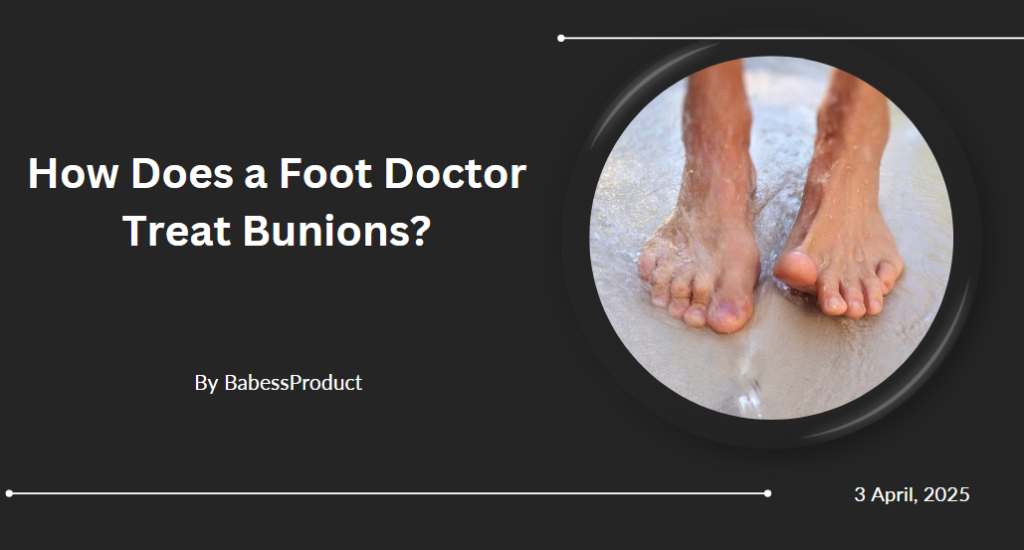Bunions are common foot deformities that cause pain and discomfort. A foot doctor can help diagnose and treat this condition. They appear as a bump on the side of the big toe. This happens when the toe joint becomes misaligned, causing the big toe to lean toward the second toe. The bump can lead to swelling, redness, and difficulty walking. A foot doctor can assess the severity of the bunion and suggest appropriate treatment options to relieve symptoms.
Non-Surgical Treatments for Bunions
When bunions are in the early stages or not too painful, a foot doctor may recommend non-surgical treatments. These methods aim to relieve pain, reduce inflammation, and prevent further worsening of the condition. A foot doctor might suggest changing your footwear as one of the simplest and most effective solutions. A podiatrist will often recommend shoes with a wide toe box and proper arch support. These shoes help reduce pressure on the bunion and prevent additional irritation.
Custom Orthotics for Bunion Relief
Custom orthotics or shoe inserts can also help manage bunion symptoms. These devices redistribute pressure across the foot and help minimize strain on the affected joint. Orthotics may prevent the bunion from worsening over time, providing long-term relief.
Padding and taping the bunion can also reduce friction from shoes. Protective padding cushions the bump, while taping can adjust the foot’s position to reduce joint pressure. These methods offer immediate comfort and help prevent further irritation.
Pain Management for Bunions
If a bunion causes inflammation and pain, your podiatrist may recommend over-the-counter medications. Nonsteroidal anti-inflammatory drugs (NSAIDs), such as ibuprofen, can help relieve pain and reduce swelling. Applying ice packs to the bunion also provides quick relief and helps manage swelling. Physical therapy can also be helpful for improving foot mobility and relieving tension around the bunion. Stretching exercises strengthen muscles and increase joint flexibility, reducing pain over time.
When Surgical Intervention is Needed
In some cases, conservative treatments may not provide adequate relief. If bunions cause persistent pain and hinder daily activities, your foot doctor might suggest surgery. Bunion surgery is often an option when other methods fail to address the symptoms effectively.
There are several surgical options available for bunion correction. Osteotomy involves cutting and realigning bones to restore proper joint positioning. Arthrodesis fuses the damaged joint, providing greater stability. Exostectomy removes the swollen bump, often in combination with other procedures for long-term improvement.
Types of Bunion Surgery
The Lapidus procedure is another option for severe bunions. This surgery fuses the first metatarsal joint to address instability at its base. The type of surgery your foot doctor recommends depends on the severity of your bunion and the unique characteristics of your foot structure.
Recovery After Bunion Surgery
The recovery process following bunion surgery can take several weeks. Most patients require 6 to 12 weeks to heal fully. During this time, you should avoid weight-bearing activities, which could disrupt healing. After surgery, physical therapy can help regain foot strength and mobility. Your doctor will give specific instructions on how to care for your foot during recovery.
Signs You May Need Bunion Surgery
Surgery may be the best option if conservative treatments fail to relieve pain. If a bunion interferes with walking or daily activities, surgery can provide lasting relief. Additionally, if the bunion leads to other problems like hammertoes, surgery may be necessary to correct the deformity.
When to Visit a Foot Doctor
It’s best to visit a podiatrist if you notice persistent pain, swelling, or difficulty finding shoes that fit. Early intervention can prevent bunions from worsening, which can lead to more complex problems later. A foot doctor will help assess the severity of the condition and recommend appropriate treatment options.
Manage Bunions With The Proper Care
Bunions may cause discomfort, but they can be managed effectively with the right care. Whether through non-surgical methods like proper footwear or custom orthotics, or through surgery when necessary, your foot doctor can guide you toward the best solution. Don’t let bunion pain disrupt your life. Reach out to a podiatrist today to start your journey toward healthier, pain-free feet.

